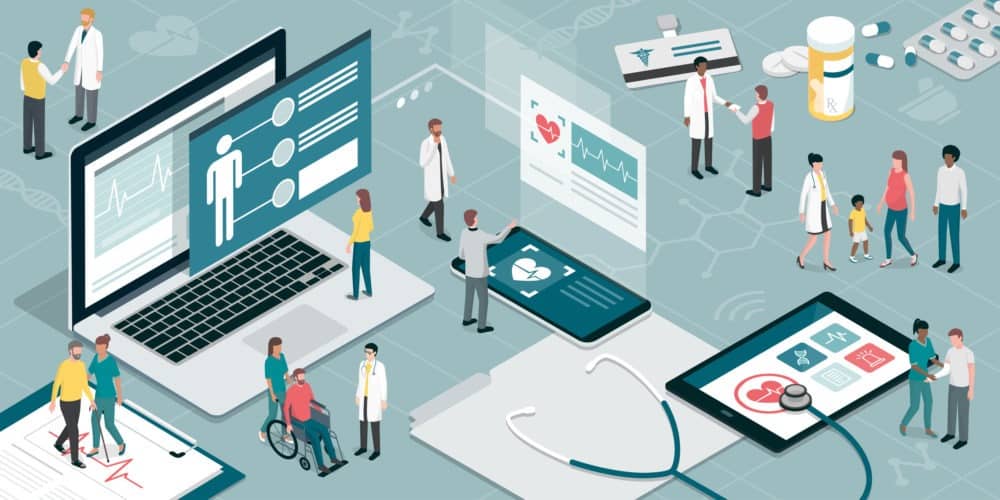After a successful industry-wide implementation of new and cutting-edge technology, it’s hard to stomach when something newer and shinier comes out. You want to take a beat and enjoy the fruits of your labor — not completely abandon the old for the new.
Many organizations have completed Electronic Health Record (EHR) implementations only to find that the EHR was not the best tool for engaging with patients. Though they’re a great way to house collective information, EHRs do not connect directly to phone systems or marketing applications. Studies show that while customers appreciate the information they can find online, 79% of consumers would still prefer to talk to real people for answers to more nuanced, personal health questions.
Of course, you don’t have to abandon EHRs to find the next best thing. But you can complement them with a customer relationship management (CRM) solution designed to elevate patient engagement. The two serve different but complementary purposes that, when combined, make for an exceptional team. There’s a common misconception that it’s EHR vs. CRM, but there are good reasons to consider EHR and CRM as a connected solution.
EHR: The seasoned solution
When EHRs were first introduced to the market, they transformed the way healthcare happened. Bringing patient records into the digital age allowed for more secure, more reliable, and more available patient information.
Within integrated EHR systems, information was now sent in moments across provider networks. And digital requests for Health Information Exchange moved faster than any faxing, scanning, or snail-mailing back and forth could in the past.
Now, through shared information via integrated systems, or data lakes where the information is consolidated and matched to a patient, all clinicians involved in a patient’s care (i.e., pharmacies, general practitioners, labs, clinics, etc.) could access a holistic view of a patient’s well-being. This allows for faster diagnosis, results, and action plans than what was previously available with paper records kept siloed from provider to provider.
But more connection and access was still needed. “The only effective solution is one that transcends the E[H]R and facilitates collaboration between clinicians within and across different organizations,” wrote Terry Edwards in a piece titled Reimagining the Role and Function of Clinical Communications in Care Delivery for HIMSS.
Amid all of this advancement, something was still missing — where did the patient, their family, and their caregivers fit in? They had access to the information, but no guidance on how to navigate it on their own. Adrienne Boissy, MD, MA notes that “It is rare that the patient is navigating [their] health alone — clinicians, communities, and the patient’s friends and family likely also have a significant role in patient care.”
CRM: The new kid in town
The next wave of digital transformation is CRM — a system of engagement that allows for the creation of personalized communication with patients based on preferences, barriers to care, and the stage of their healthcare journey. This makes it so each patient experience is uniquely suited to them. From communicating via emails, texts, or phone calls to receiving information in native languages, based on geography, or aligning with patient insurance requirements — CRMs help make healthcare personal and approachable.
A CRM also provides a bird’s eye view of an organization’s relationships and interactions with current and prospective customers. With streamlined processes, improved customer connections, and data-based insight into trends, needs, and preferences — a CRM makes a better experience for both patients and providers. Employing a CRM tool, like Salesforce Health Cloud for example, can create a consistent experience for all agents, managers, and nurses across call centers and locations. Doing so helps cut down time required to identify patient needs or connect callers to the right resource.
CRMs also poise their users for improved profitability. Likewise, a CRM can help organizations realize a greater return on investment for the time and money put into introducing EHRs. Studies show that U.S. hospitals with excellent patient experiences generate 50% higher financial performance than average providers.
EHR and CRM: Better together
Implementing a CRM into an already existing EHR environment only elevates EHR capabilities — it doesn’t remove their benefits. By bringing patient information together from multiple sources, even more data types can be analyzed — social, behavioral, demographic, economic, and clinical all together in one org. CRMs allows providers to consider the patient’s experience throughout their health journey, not solely the communication need at certain milestones.
With the combined power of EHR and CRM, excellent patient-centered care is more achievable than ever. Less time can be spent confirming details from different sources of care — and more time can be spent getting to know the patient and their needs. Communication can happen via text, email, phone calls, snail-mail, and more. Whatever works best for your patient, in turn, works best for you. When patients feel seen, heard, and cared for, they’re more likely to return when future health needs arise. By establishing excellent care from the start, you’re building trust that ensures lower patient turnover and higher patient engagement.
Ready to take the next step? Learn more about our Salesforce EHR integration solutions.




